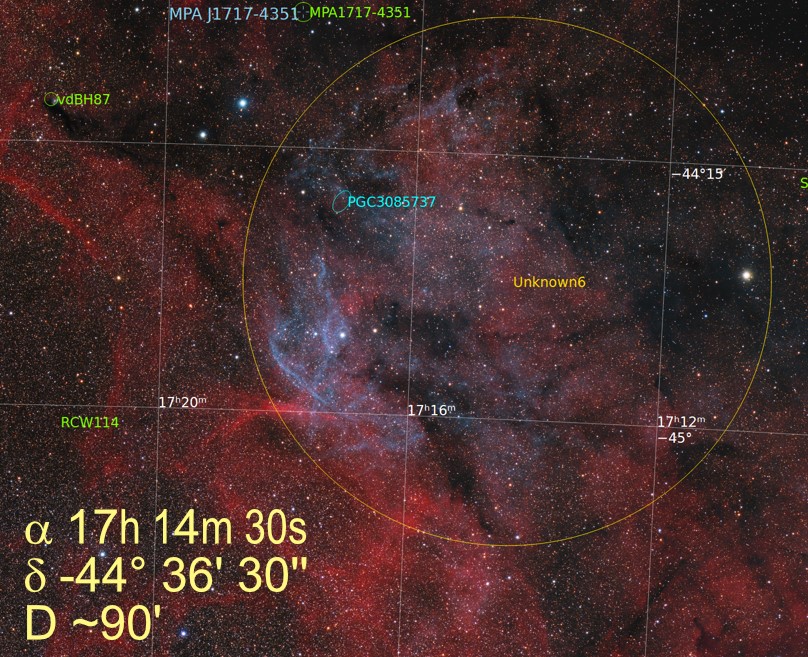
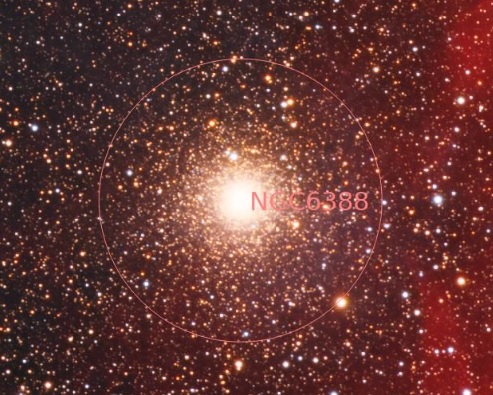
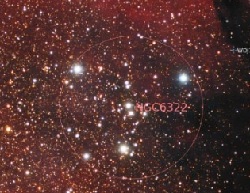
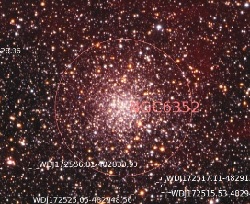
Unknowm OIII fillaments
NGC 6388
NGC 6322
NGC 6352
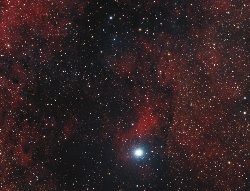
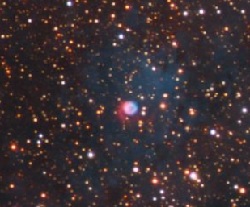
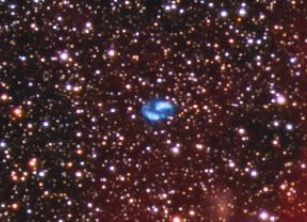
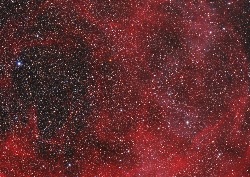
eta Sco & vdBH 83
PK 342-02.1 (aka Pe 1-8)
PK 342-04.1 (Hen 2-207)
WR 90 and shock front
[back] RCW 114 (Dragon's Heart) in Ara
(c) 2024 All astro photo images are copyrighted. They may not be used or reproduced without explicit written permission from the authors.
Please use next|prev (upper
right) to switch between image and annotated image.
Bitte verwenden Sie next|prev (oben rechts) um zwischen
Bild und beschriftetem Bild umzuschalten.
Click on one of the images below to bring up some highlights
in the image above (you may need the right scroll bar to scroll up)
Klick auf eines der Bilder unten zeigt einige Highleights im Bild oben
(ggf. benutzen Sie die Bildlaufleiste rechts, um nach oben zu scrollen
|
|
|
|
|
|
Unknowm OIII fillaments |
NGC 6388 |
NGC 6322 |
NGC 6352 |
|
|
|
|
|
|
eta Sco & vdBH 83 |
PK 342-02.1 (aka Pe 1-8) |
PK 342-04.1 (Hen 2-207) |
WR 90 and shock front |
About this Image / Über dieses Bild
| Camera: | Moravian C3-PRO-61000 Mono CMOS |
| Image Type, Orientation: | Ha/OIII RGB near real color 2x3 Mosaik, North is at 12:00 |
| Exposure time: | Ha: 60x300 sec., OIII: 120x300 sec., R,G,B: 18x300s (19:30h) for each panel, 117h total |
| Exposure date: | May 15th...July 4th, 2024 |
| Location: | Capella Observatory South at Kiripotib Astro Farm, Namibia |
| Filter: | Astronomik 6nm Ha, OIII filters and Astronomik Deep-Sky Deep-Sky RGB Filter on Moravian EFW-3L-9-II External Filter Wheel |
| Instrument: | "Callisto", a Takahashi FSQ 106N, 530mm focal length, 106mm aperture, f/5 on modified Losmandy G11 (high res encoders with OnStepX) |
| Photographer: | Rainer Raupach, Josef Pöpsel, Frank Sackenheim |
| Remarks: |
RCW 114, also known as the "Dragon's Heart," is primarily
a supernova remnant (SNR) located in the southern Milky Way. In the catalog
by Rodgers, Campbell, and Whiteoak, the object is listed as an HII region
due to the strong Hα emission observed at the shock front. The entire image,
presented as a 2 x 3 mosaic, covers a sky area of approximately 6.5° x 6.5°
with a pixel scale of 1.5 arcseconds. This resolution reveals far more
detail than a typical wide-angle shot of this region. The apparent diameter
of the heart-shaped structure is about 5° x 6°, equivalent to 10 x 12 times
the diameter of the full moon. According to current scientific understanding [1], the Hα-visible SNR is associated with the pulsar PSR J1731-4744 (also known as PSR B1727-47 in galactic coordinates), located at the heart’s apex. What is predominantly visible is one cavity of the bipolar structure, which extends northwestward and forms the "Dragon's Heart." Additionally, the Wolf-Rayet star WR 90 in the right part of the heart generates a bubble-shaped shock front that expands into the material of the SNR [2]. While the field around RCW 114 has been frequently imaged in Hα, there are, to our knowledge, no deep observations in other wavelengths typical of emission lines. One of the referenced papers [2] investigates other emission lines (such as SII, NII, and SiII), but they are not displayed spatially. A key feature of the presented image is the deep OIII contribution, which reveals structures not previously observed. The OIII signal is extremely faint and significantly contaminated by overlap with continuum radiation. To make the OIII structures clearly visible, continuum subtraction is essential. In this case, it was performed using the intensity distribution from the green and blue filters. After applying this technique, faint filaments in the northwestern part of the image become visible, the origin of which remains unknown (see image below). It is unlikely that the Wolf-Rayet stars in the field play a role. The shape of the filaments does not align with any influence from WR 90 (HD 156385, with a parallax of 0.723 mas, corresponding to a distance of about 4,500 light-years). The two other WR stars in apparent proximity are much farther away based on their parallaxes: WR 92 (HD 157451, parallax of 0.195 mas) and WR 83 (MR 67, parallax of 0.1931 mas), both approximately 17,000 light-years distant. Optically, the B-star (HD 155985, located within the OIII filaments on the left) could appear to be the source of the excitation leading to emission. Given the star's distance (parallax of 0.896 mas, or about 3,600 light-years), this could be a plausible explanation. On the other hand, the filaments might be connected to a source located outside the right edge of the image field and, along with the visible filaments on the outer western edge, could represent a second shell of a larger structure. Further investigation is required to answer this question. |
|
|
|
| Bemerkungen: |
Bei RCW 114, dem “Drachenherz”, handelt es sich primär um einen
Supernova-Überrest (SNR) in der südlichen Milchstraße. Im Katalog von
Rodgers, Campbell und Whiteoak taucht das Objekt als HII-Region auf, weil an
der Stoßfront vor allem Hα-Emission zu beobachten ist. Das gesamte Bild
stellt als 2 x 3 Mosaik einen Himmelsausschnitt von ca. 6.5° x 6.5° mit
einem Pixelraster von 1.5 Bogensekunden dar. Gegenüber einer typischen
Weitwinkelaufnahme dieser Region sind daher viel mehr Details erkennbar. Der
scheinbare Durchmesser der herzförmigen Struktur beträgt etwa 5° x 6°, also
10 x 12 Vollmond-Durchmesser. Nach aktuellen wissenschaftlichen Erkenntnissen [1] ist der in Hα sichtbare SNR mit dem in der Spitze des Herzens lokalisierten Pulsar PSR J1731-4744 (= PSR B1727-47 in galaktischen Koordinaten) assoziiert. Sichtbar ist vornehmlich die eine Kavität der bipolaren Struktur, die sich nach Nord-Westen als das Drachenherz erstreckt. Zusätzlich generiert der Wolf-Rayet-Stern WR 90 im rechten Teil des Herzens eine blasenförmige Stoßfront, die sich in das Material des SNR ausdehnt [2]. Während das Feld um RCW 114 in Hα schon oft dargestellt wurde, gibt es unseres Wissens keine tiefen Aufnahmen in anderen Wellenlängen typischer Emissionslinien. In einem der zitierten Paper [2] werden zwar auch andere Emissionslinien (z.B. SII, NII, SiII) untersucht, jedoch nicht als räumliche Verteilung abgebildet. Eine Besonderheit des hier präsentierten Bildes stellt deswegen der tiefe OIII-Beitrag dar und zeigt Strukturen, die bisher noch nirgendwo gezeigt wurden. Die Information in OIII ist dabei so schwach, dass sie vom Überlapp mit dem Kontinuum erheblich überlagert und kontaminiert wird. Um die Information überlagerungsfrei sichtbar zu machen ist eine Kontinuum-Subtraktion unabdingbar und hier unter Verwendung der Intensitätsverteilung des Grün- und Blau-Filters durchgeführt worden. Nach Anwendung dieses Verfahrens sind feine Filamente im nordwestlichen Teil des Bildes sichtbar (siehe Bild unten), deren Ursprung unbekannt ist. Wahrscheinlich spielen die Wolf-Rayet-Sterne im Feld dabei keine Rolle. Die Form der Filamente passt nicht zu einem Einfluss von WR 90 (HD 156385, Parallaxe 0.723 mas entsprechend einer Entfernung von etwa 4500 Lichtjahren), die beiden anderen WR-Sterne in scheinbarer Nähe sind außerdem entsprechend ihrer Parallaxen viel weiter entfernt: WR 92 (HD 157451, Parallaxe 0.195 mas), WR 83 (MR 67, Parallaxe 0.1931 mas, beide folglich ca. 17000 Lichtjahre entfernt. Optisch könnte der Eindruck entstehen, dass der B-Stern (HD 155985, links innerhalb der OIII-Filamente) die Quelle für die Anregung zur Emission sein könnte. In Bezug auf die Entfernung des Sterns (Parallaxe 0.896 mas entsprechend 3600 Lichtjahre) wäre dies eine plausible Erklärung. Andererseits könnten die Filamente in Verbindung mit einer Quelle rechts außerhalb des Bildfeldes stehen und neben den ebenfalls sichtbaren Filamenten westlich am äußeren Rand eine zweite Schale einer größeren Struktur repräsentieren. Dies muss weiter untersucht werden.
|
Analysis of nebula structures in RCW 114
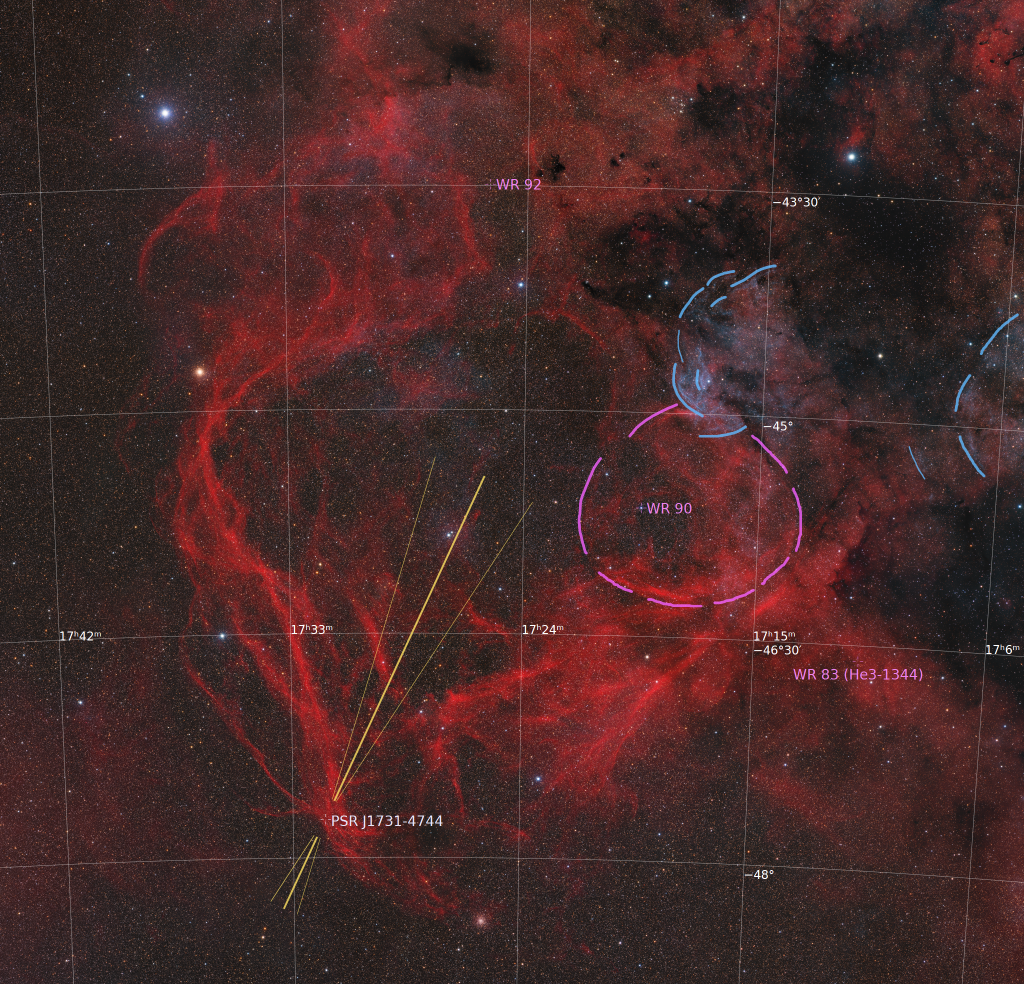
Back to the Supernovae-Remnants Overview / Zurück zur Supernovae-Überreste-Übersichtsseite